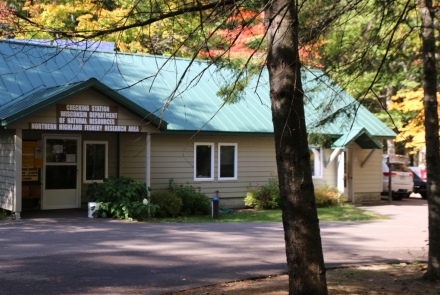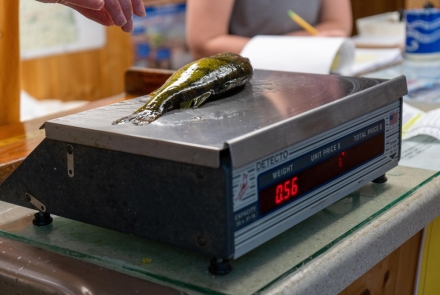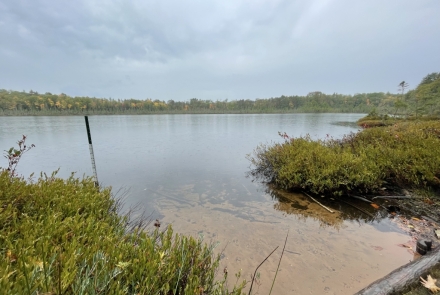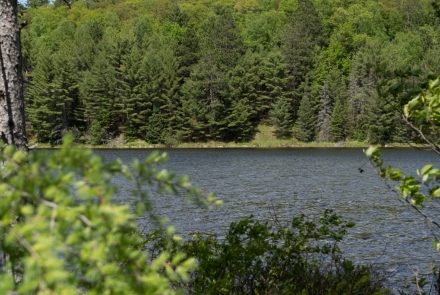Fish The NHFRA
What You Need To Know For Your Trip
The Northern Highland Fishery Research Area (NHFRA) is open 365 days a year, with DNR staff on site to assist anglers at the Escanaba Lake Check Station, located at the Escanaba Lake boat launch, 9588 Nebish Lake Road, Sayner, WI 54560.
All anglers must check in at the station and obtain their free permit before fishing. Permits are required to fish. Fishing hours start at 4 a.m., but the station opens daily at 7 a.m. and closes depending on the season (see hours and regulations below). Anglers fishing prior to the daily 7 a.m. opening of the Escanaba Lake Check Station are required to use the self-registration kiosk at the check station and check out in person after 7 a.m. the same day. Check-ins and check-outs ensure the accuracy of the data in the NHFRA database!
Depending on the lake you fish, species may have tags and different ongoing study needs, such as Escanaba musky or walleye and Pallette smallmouth bass. PIT tags are often placed in muskellunge to track the fish over time, and a PIT tag reader is supplied to musky anglers at check-in. Floy tags, a spaghetti-like tag near the dorsal fin or upper back, are also often used to tag fish. More information is included in lake-specific sections below, and NHFRA staff can also provide information at the station.
At check-out, NHFRA fisheries technicians, biologists and research scientists will chat with you about your trip and collect information such as time spent fishing, fishing methodology, and targeted species. They will also record harvested fish information, such as weight and length. Staff may also ask for specific information on species caught and released.
FISHING HOURS
All anglers must be off the water by the end of designated daily fishing hours. NHFRA staff also reserve the right to close early during fieldwork seasons. If the station closes early for fieldwork, anglers will be notified upon check-in.
*(ice) - Earlier check station closing time due to the seasonal transition from ice to open water
**(field season) - Earlier check station closing time to accommodate seasonal fisheries field surveys
| MONTH | HOURS |
|---|---|
| January | 4 a.m. - 6 p.m. |
| February | 4 a.m. - 7 p.m. |
| March | 4 a.m. - 8 p.m. |
| April | 4 a.m. - 8 p.m. (ice)* 4 a.m. - 9 p.m. (field season)** 4 a.m. - 10 p.m. (after field season) |
| May | 4 a.m. - 9 p.m. (ice)* 4 a.m. - 9 p.m. (field season)** 4 a.m. - 10 p.m. (after field season) |
| June | 4 a.m. - 10 p.m. |
| July | 4 a.m. - 10 p.m. |
| August | 4 a.m. - 10 p.m. |
| September | 4 a.m. - 9 p.m. (field season)** |
| October | 4 a.m. - 8 p.m. (field season)** |
| November | 4 a.m. - 7 p.m. |
| December | 4 a.m. - 6 p.m. |
CURRENT REGULATIONS
There are no recreational fishing regulations (length limits, bag limits, closed seasons) on the NHFRA lakes outside the NHFRA fishing hours, check-in/check-out rules, and lake-specific fishing regulations for experimental purposes. Live bait is allowed unless explicitly stated in individual lake regulations.
Permits are required to fish on the five NHFRA lakes, and anglers are also required to check out at the end of the day. View an interactive map of all five lakes via Surface Water Data Viewer.
LEAD TACKLE RESTRICTION: Lead tackle of less than one ounce or an inch in any dimension is prohibited on Escanaba, Nebish and Pallette lakes.
Escanaba Lake is a 293-acre lake with a maintained boat launch and is where the check-in station is located. In Ojibwemowin, Escanaba is called Zhooshkwaabika-zaaga'igan, meaning smooth or slippery rocks lake. Escanaba has the most extended fisheries survey history of any lake within the NHFRA and has contributed significantly to our overall understanding of some of Wisconsin's most popular fish species' behavior, reproduction, diet and life history.
Lake Map
SPECIES
- Walleye
- Muskellunge
- Northern pike
- Smallmouth bass
- Largemouth bass
- Yellow perch
- Panfish (bluegill, pumpkinseed, rock bass)
REGULATIONS
Walleye
Opening day is the second Saturday of June; closing day is the first Sunday in March. Recreational walleye fishing is prohibited from closing day to opening day; catch-and-release walleye fishing is not permitted during this period.
- 15-inch minimum length limit
- 20-24 inch protected no harvest slot length limit
- Daily bag limit 3 walleye, with no more than one walleye over 24 inches allowed
Reason for regulation: A walleye production overharvest experiment is ongoing on Escanaba Lake. At the Escanaba Lake Check Station, walleye anglers can monitor the remaining walleye quota available for harvest. Previously, a trophy harvest regulation on walleye was in place from 2003-2022 to study the effects of low harvest pressure—now, the research objective has changed to study the impact of increased harvest levels on a formerly unexploited walleye population.
All other species in Escanaba: No closed season, length limits, or daily bag limits.
HELP US COLLECT DATA AND LEARN ABOUT YOUR CATCH
To aid other Northern Highland Fishery Research Area (NHFRA) research projects, anglers are being asked to record information on catch-and-release fish, such as tag number, length, and general location where the fish was caught.
Musky
We'll supply a PIT tag reader to use during your fishing trip so you can scan any musky you catch and learn about the catch and release history of that musky! When you catch your musky, make sure to note the PIT tag number, the length of the fish, and the general location where you caught the fish.
How this dataset helps: Musky are notoriously difficult for anglers and biologists alike to catch, and we want to take advantage of any opportunity to collect data on these elusive fish. Any time an angler catches a musky, it provides a unique opportunity to assess the growth and movement of the musky over time on an individual and population level. These data are beneficial in understanding how populations change over time and how we can best manage them across Wisconsin.
Walleye
If your walleye has a floy tag (see right), take note of the numbers on the tag, the length of the fish, and the general location where you caught the fish, and bring that data back to the station when you check out.
How this dataset helps: With the rise of catch and release angling, more fish are caught many times within a relatively short time span. Current data in a natural environment is somewhat limited in testing the effects of catch-and-release fishing on walleye populations. By gathering data on tagged walleye that are released, we can track the number of catch and release events for each fish and test whether catch frequency affects survival, growth and reproduction.
Pallette is the deepest lake in the NHFRA, with an average depth of 30 feet and a maximum of 60 feet, and is known for its clear, cold water. Pallette is only accessible for boats by carry-in or portage (0.4-mile carry-in or short portage from Escanaba Lake). This lake currently serves as an important study site for understanding the long-term effects of harvest and trophy regulations on smallmouth bass populations and as a sentinel lake for the influences of climate change on fish.
Lake Map
SPECIES
- Northern pike
- Muskellunge
- Yellow perch
- Smallmouth bass
- Rock bass
- Cisco
REGULATIONS
Smallmouth bass
- 22-inch minimum length limit, daily bag limit of 1 smallmouth bass
- Only smallmouth bass greater than 22 inches may be harvested
Reason for regulation: To create trophy smallmouth bass fishing opportunities and study the impacts of trophy regulations on smallmouth bass populations.
All other species:
There is no closed season, length limit, or daily bag limit for any other species.
HELP US COLLECT DATA AND LEARN ABOUT YOUR CATCH
To aid Northern Highland Fishery Research Area (NHFRA) research projects, anglers are being asked to record information on catch-and-release fish, such as tag number, length, and location.
Smallmouth bass: If your smallmouth bass has a tag number, record the tag number, the fish length if you are catching and releasing, and the catch location, and bring that information back to the station when you check out.
How this data helps: We are researching individual bass's vulnerability to angling. By collecting the tag numbers and lengths, we can track the catch frequency and the growth of that particular fish over time. This helps us assess if certain bass are caught more frequently than others and if they have different growth trends. This is potentially important because it lets us know if angling pressure is evenly applied to an entire population or if certain individuals are more heavily exploited.
A 93-acre oligotrophic lake, Nebish is the only other lake in the NHFRA that has a maintained boat launch. Its original name in Ojibwemowin is Aniibiishi-zaaga'igan, meaning tea lake or lake without an inlet or outlet. Two campsites are available at Nebish—campsites must be reserved with DNR Parks. Nebish has been used in many scientific studies, such as introducing trout species to inland lakes, rehabilitating inland lakes, and influencing regulations on smallmouth bass.
Lake Map
SPECIES
- Smallmouth bass
- Yellow perch
REGULATIONS
Smallmouth bass
- 14-inch maximum length limit, daily bag limit of 5 smallmouth bass
- Only smallmouth less than 14 inches may be harvested
Reason for regulation:
Nebish Lake has had a long history of smallmouth bass (SMB) regulation changes to test for responses on size structure, angler habits, and population density. From 1989 to 2017, the regulation for SMB on Nebish Lake was a 9-12" protected no harvest slot length and 5 bag limit per person. This reduced total harvest as anglers tended to harvest fewer, larger fish during this period. As a result, the density of SMB continually increased, and stunting was observed (more small fish) with very few larger fish.
In 2018, the regulation was changed to a 14" maximum length limit and a 5 daily bag limit to promote the harvest of small bass and encourage the growth of SMB. Anecdotally, we have observed more fish exceeding the maximum length limit, with some anglers reporting catch and release of SMB in the 17-20" category when there had been none before. We encourage anglers to harvest their daily bag so that we can observe the continued effects of selective harvest on this population. Selective harvest is often required to structure fish populations to meet angler desires for larger fish and high catch rates.
All other species:
There is no closed season, length limit, or daily bag limit for any other species.
HELP US COLLECT DATA AND LEARN ABOUT YOUR CATCH
Currently, we are not collecting fish tag numbers on Nebish. However, if you bring the tag numbers and fish length in, NHFRA staff can look your fish up in the database if you're curious about the history of your catch!
A 16-acre bog lake, Spruce, is accessible a short distance from Nebish Lake Road via a canoe ramp carry-in. Spruce Lake is a typical small bog lake surrounded by sphagnum moss and low-lying wetland shrubs. Spruce Lake was the study site for seminal winter kill and across-bog fish migration studies and is a key piece in understanding the under-ice ecology of Wisconsin fishes.
Lake Map
SPECIES
- Largemouth bass
- Yellow perch
REGULATIONS
Largemouth bass
- 12-inch minimum length limit, daily bag limit of 2 largemouth bass
- Artificial lures only
All other species:
There is no closed season, length limit, or daily bag limit for any other species
Mystery is a shallow, boggy lake near Spruce Lake with a maximum depth of 7 feet. It is accessible via a short access road off Nebish Lake Road. The carry-in trail to Mystery is about .2 miles through a wetland trail. This lake winter kills every winter. Mystery Lake typically does not support a large fish population, and fishing opportunities are minimal.
Lake Map
SPECIES
- Central mud minnow and other winterkill-adapted minnow species; no appreciable sportfish populations
REGULATIONS
There are no recreational fishing regulations, closed seasons, length limits, or daily bag limits.












